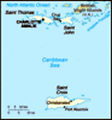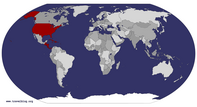Advertisement
Published: October 17th 2008
The United States Virgin Islands is a group of islands in the Caribbean that are an insular area of the United States. The islands are geographically part of the Virgin Islands archipelago and are located in the Leeward Islands of the Lesser Antilles.
The U.S. Virgin Islands consist of the main islands of Saint Croix, Saint John and Saint Thomas, along with the much smaller but historically distinct Water Island, and many other surrounding minor islands. The total land area of the territory is 346.36 km² (133.73 sq mi). As of the 2000 census the population was 108,612.
Three of the main islands have nicknames often used by locals: "Twin City" (St. Croix), "Rock City" (St. Thomas), "Love City" (St. John), and "Small City" (Water Island).
The Virgin Islands were originally settled by the Ciboney, Carib, and Arawaks. The islands were named by Christopher Columbus on his second voyage in 1493 for Saint Ursula and her virgin followers. Over the next three hundred years, the islands were held by many European powers, including Spain, Britain, the Netherlands, France, and Denmark-Norway.
The Danish West India Company settled on Saint Thomas in 1672, on Saint John in 1694, and purchased
Saint Croix from France in 1733. The islands became royal Danish colonies in 1754, their name translating to Jomfruøerne in Danish. Sugarcane, produced by slave labor, drove the islands' economy during the 18th and early 19th centuries, until the abolition of slavery by Governor Peter von Scholten on July 3, 1848.
For the remainder of the period of Danish rule, the islands were not economically viable and significant transfers were made from the Danish state budgets to the authorities in the islands. In 1867 a treaty to sell Saint Thomas and Saint John to the United States was agreed, but the sale was never effected. A number of reforms aimed at reviving the islands' economy were attempted, but none had great success. A second draft treaty to sell the islands to the United States was negotiated in 1902 but was narrowly defeated in the Danish parliament.
The onset of World War I brought the reforms to a close and again left the islands isolated and exposed. During the submarine warfare phases of the First World War, the United States, fearing that the islands might be seized by Germany as a submarine base, again approached Denmark with a view to
buying them. After a few months of negotiations, a selling price of $25 million was agreed. The Danish Crown may have felt some pressure to accept the sale, thinking that the United States would seize the islands if Denmark was invaded by Germany. At the same time the economics of continued possession weighed heavily on the minds of Danish decision makers, and a bipartisan consensus in favor of selling emerged in the Danish parliament. A subsequent referendum held in late 1916 confirmed the decision to sell by a wide margin. The deal was thus finalized on January 17, 1917, when the United States and Denmark exchanged their respective treaty ratifications. The U.S. took possession of the islands on March 31, 1917 and the territory was renamed the Virgin Islands of the United States.
U.S. citizenship was granted to the inhabitants of the islands in 1927.
Water Island, a small island to the south of Saint Thomas, was initially administered by the U.S. Federal government and did not become a part of the U.S. Virgin Islands territory until 1996, when 50 acres of land was transferred to the territorial government. The remaining 200 acres (0.81 km2) of the island
were purchased from the US Department of the Interior in May 2005 for $10, a transaction which marked the official change in jurisdiction
The U.S. Virgin Islands are known for their white sand beaches, including Magens Bay and Trunk Bay, and strategic harbors, including Charlotte Amalie and Christiansted. Most of the islands, including Saint Thomas, are volcanic in origin and hilly. The highest point is Crown Mountain, Saint Thomas (474m). Saint Croix, the largest of the U.S. Virgin Islands, lies to the south and has a flatter terrain. The National Park Service owns more than half of Saint John, nearly all of Hassel Island, and many acres of coral reef. (See also Virgin Islands National Park, Virgin Islands Coral Reef National Monument, Buck Island Reef National Monument, Christiansted National Historic Site, and Salt River Bay National Historical Park and Ecological Preserve.)
The Virgin Islands lie on the boundary of the North American plate and the Caribbean Plate. Natural hazards include earthquakes, tropical cyclones, and hurricanes.
Saint John is an island in the Caribbean Sea and a constituent district of the United States Virgin Islands (USVI), an unincorporated territory of the United States. It is renowned as the wealthiest and
most expensive of the U.S. Virgin Islands, enjoying a level of affluence that is comparable with the nearby island of St. Barts. St. John is located about 4 miles east of Saint Thomas, the location of the territory's capital, Charlotte Amalie, and 4 miles south and west of Tortola, part of the British Virgin Islands. It is 50.8 km² (19.61 sq mi) in area and has a population of 4,197 (2000 census) . Because there are no airports on St. John, the only access to the island is by boat. The ferry service runs hourly from St. Thomas and daily from Tortola; regular ferries also operate from Virgin Gorda, Jost Van Dyke and Anegada
St. John was first settled by the Arawak Indians who had migrated north from coastal Colombia and Venezuela around AD 300. The Arawaks inhabited the island until around the year AD 1300, when they were driven off by the more aggressive and warlike Carib Indians. Extensive archaeological work has been undertaken from 1996 to the present at Cinnamon Bay. The artifacts from this dig are currently being studied and should yield more detailed information on pre-Columbus civilization in the Virgin Islands (Taino).
Christopher Columbus is credited with being the first European to see the Virgin Islands during his second voyage to the New World in 1493. He named the island group "Once Mil Virgenes", or Eleven Thousand Virgins, in honor of the feast day of Saint Ursula and the 11,000 virgins who were martyred with her.
The Danish West India and Guinea Company represented the first Europeans to settle the island in 1718. They are also credited with naming the island St. John (Danish: Sankt Jan). The Danish crown took full control of the colony in 1754, along with St. Thomas and St. Croix. Sugar plantations, such as the famous Annaberg Sugar Plantation, were established in great numbers on St. John because of the intense heat and fertile terrain, which provided ideal growing conditions. The establishment of sugar plantations also led to the importation of more slaves from Africa. St. John was the site of one of the first significant slave rebellions in the New World in 1733, when slaves took over the island for six months.
The Danish were able to defeat the enslaved Africans with help from the French in Martinique. Many Africans committed suicide by jumping off cliffs instead of returning to slavery, as they commonly believed that when they died they would return to Africa. It is estimated that by 1775, slaves outnumbered the Danish settlers by a ratio of 5:1. The indigenous Caribs and Arawaks were also used as slave labor, to the point of wiping out their entire population. Slavery was finally abolished in St. John on July 3, 1848.
In 1917 the United States of America bought the Virgin Islands from the Danish government in order to establish a naval base whose purpose was to prevent German expansion in the western hemisphere. The U.S. government paid $25 million for the three islands. They also agreed to recognize Denmark's claim to Greenland, which they had previously disputed.
Virgin Islanders are now U.S. citizens, although they cannot vote in U.S. presidential elections and have only non-voting status in Congress. The Virgin Islands are an organized, unincorporated territory of the US, and since 1972 have elected their own Governor. They enjoy a large degree of self-rule through a local 15-seat legislature that covers all three of the islands.
In 1956, Laurance Rockefeller donated most of the land he had acquired on the island to the United States' National Park Service, under the condition that it must be protected from future development. The remaining portion, the Caneel Bay Resort, continues to operate on a lease arrangement while the park owns the actual land. The Virgin Islands National Park borders encompass 75% of the island, but various in-holdings within the park boundary (eg. Peter Bay, Maho Bay) reduce the actual land the park owns to 60%. However, much of the island's waters, coral reefs and shoreline are protected via their inclusion in the park. This protection was expanded in 2001, when the Virgin Islands Coral Reef National Monument was created.
Water Island is the fourth and most recently acquired main island in the U.S. Virgin Islands, a United States territory located in the Caribbean Sea. The island is of volcanic origin and lies to the south of Saint Thomas in the Charlotte Amalie harbor. Ferry service runs regularly from Crown Bay, Saint Thomas to Phillips Landing, Water Island; the ferry ride is about 10 minutes.
At 491.5 acres (1.989 km2) in size, Water Island is the smallest of the main U.S. Virgin Islands. It is administratively a part (subdistrict) of the St. Thomas District. Water Island is a residential island, with a population of 161 (2000 census) and no significant commercial establishments. A number of homes on Water Island are available to accommodate visitors. The main attractions are beaches, including Honeymoon Beach, plantation ruins, and Fort Segarra, an underground fort partially constructed by the U.S. during World War II. The northern end of the island is a gated community, Sprat Bay Estates, which includes Sprat Bay Beach. All of the beaches in the USVI are public. This is our favorite Virgin Island!
Advertisement
Tot: 0.265s; Tpl: 0.012s; cc: 11; qc: 63; dbt: 0.0925s; 1; m:domysql w:travelblog (10.17.0.13); sld: 1;
; mem: 1.2mb










